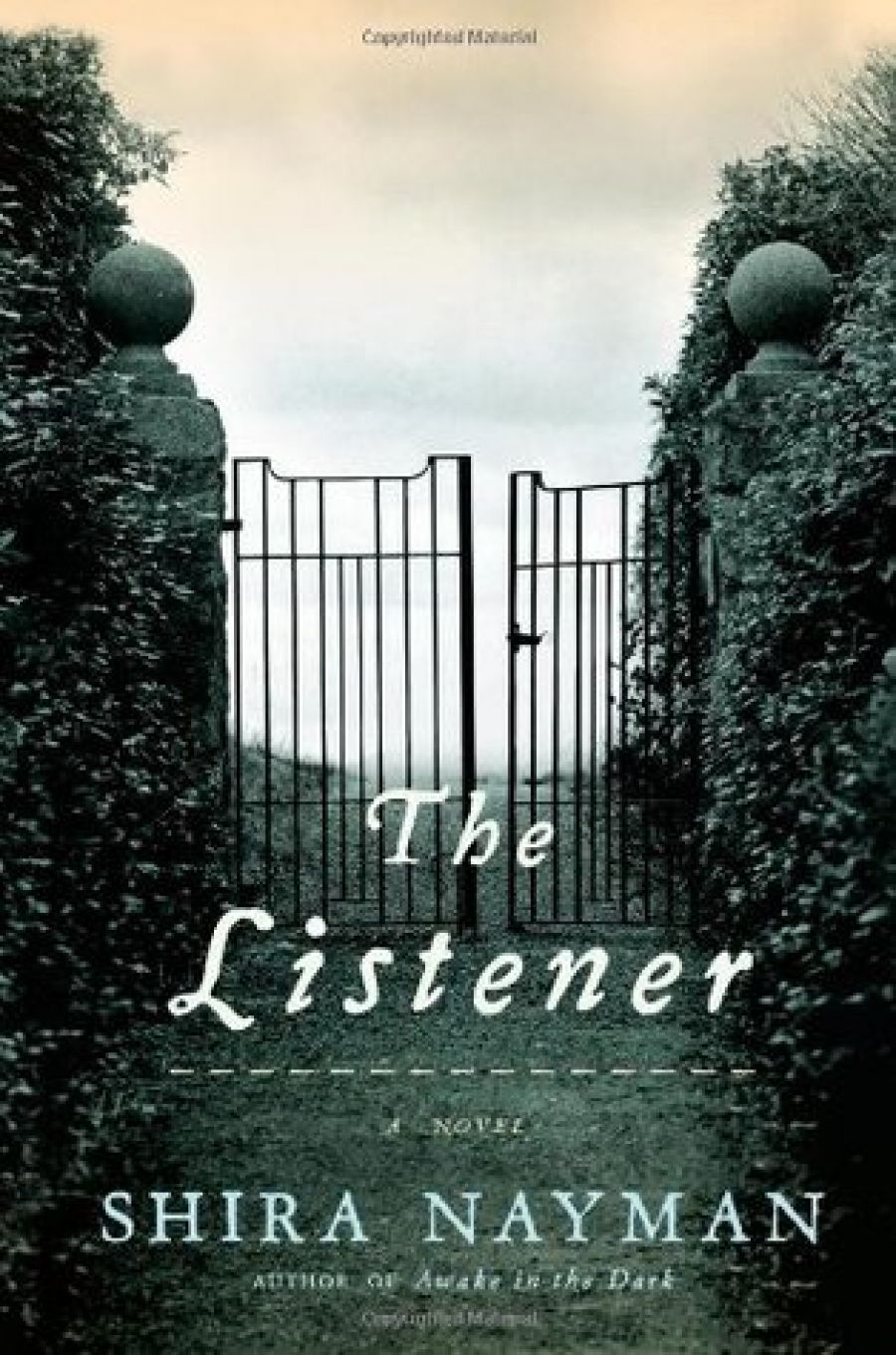
- Free Article: No
- Contents Category: Fiction
- Custom Article Title: Claudia Hyles reviews 'The Listener' by Shira Nayman
- Review Article: Yes
- Article Title: Staunching waste
- Online Only: No
- Custom Highlight Text:
Shira Nayman’s first novel is full of echoes and resonances. There may even be an echo of Bernhard Schlink’s The Reader. Set at more or less the same time, The Listener has the same immediate backdrop: World War II, its atrocities and aftermath.
Two years after the end of the war, Dr Henry Harrison – the narrator and listener of the piece – encounters a man who will become his most memorable case. Dr Harrison is the director and chief psychiatrist of Shadowlands, a private mental hospital located at White Plains, not far from New York. The exclusive institution is grand, more of a country club than an asylum, with beautiful buildings, extensive woods and formal gardens. Inmates, though voluntarily committed, are known as ‘patients’, not the more egalitarian ‘clients’ or euphemistic ‘guests’ of the present day. Many of them are suffering from war neurosis, a condition that Dr Harrison has been treating for many years. During the war he was required to treat mentally disturbed or shell-shocked officers and to send them back, supposedly cured, to the front. This was to ‘staunch the wastage’, according to the army. Over time he has come to doubt the efficacy of this treatment. By researching complex cases such as that of Bertram Reiner, he seeks to refine his methods.
- Book 1 Title: The Listener
- Book 1 Biblio: Simon & Schuster, $26.99pb, 308 pp
By 1947 the heroic homecomings are over and the all-American happy families are somewhere else. Patients are so mentally scarred that they need expert clinical help to heal their psychological wounds, but some of the healers have also suffered traumatic war experiences. Nurse Matilda Willoughby is a survivor of Bataan and Corregidor; Harrison, a veteran of both wars, is haunted by appalling reminders of the Western Front; and Reiner, the patient whose tortured psyche and complicated story the novel sustains so cleverly, has been exposed to just about every dreadful incident that World War II in Europe could produce.
But has he really? Reiner is intelligent and cunning, and the web of fabrications he weaves, including his own death, is inexplicable. He exposes moral quandaries for both Matilda and Harrison, and the question of collaboration, past and potential, hangs like a noose over everyone’s heads. The concept of truth recurs again and again, and all the main characters find that their sense of clarity is muddied. Matilda observes that ‘craziness is not the sole territory of the insane’, while one odd patient says in his slightly unreal farewell speech, ‘It’s easy to forget ... that we’re all just a little cracked’. What is or was the incidence of carers for the insane becoming ‘just a little cracked’? How often did a carer and a patient fall in love and live happily ever after?
Shadowlands is a place of ‘exaggerated grandness’. Wealthy patients have their own servants, and medical staff don tuxedos and evening dress for dinner dances in the chandelier-lit hall. Treatments are described in detail, but somehow it all seems like a weird variation on a resort or holiday camp. Patients at Christmas are described as looking like ‘liberated co-eds’. Life at Shadowlands is ‘a rest cure with a twist’ and a ‘living specimen jar’.
A Midsummer Night’s Dream is chosen as the play for a pageant produced by patients. Dreams feature throughout the novel, somewhat histrionically opium-induced in Harrison’s case. Acting ‘the Dream’ is poignant as ‘most ... know what it’s like to wake up one day and find the world has undergone a baffling metamorphosis’. War experiences amplify this, leaving many in a state of constant terror. Others have retained a sense of humour, but jokes often backfire.
The author, an Australian now living in the United States, has a doctorate in clinical psychology. This gives her a clear advantage, but her botanical de-tails at least are a little inaccurate. There is a distinct whiff of celluloid in the book, a sensation that one has visually strayed onto the 1940s set of a black-and-white Hollywood drama where nurses still wear starched caps and people smoke. Inhabiting the set is a remote Gregory Peck, a brave Katharine Hepburn, a couple of dutiful Olivia de Havillands and an amalgamation of Gary Cooper, Hardy Kruger and Marlon Brando as Reiner ‘in his quiet, leading-man sort of way’. Movie sets lack the dimension of reality, even when based on real places. Harrison has an ‘unexpected fantasy ... something from a movie I once saw’.
The plot, however, is skilful and shrewdly deployed. The elegance and beauty of the Shadowlands environs belie the turmoil within, the Gothic ‘secret’ tunnels and the occasional success in the patients’ Suicide Club. The narrative, at times, is very suspenseful. The diligent professionals, with their own psychic struggles, descend to the brink of madness, affected by Reiner’s enigma and complexity. The stage is like a suspension bridge in a jungle. Harrison and Matilda are the sapling pylons, bending to the point of snapping, and Reiner is the swinging, slewing, swerving pathway connecting them, hanging precariously over a fathomless ravine.


Comments powered by CComment